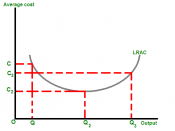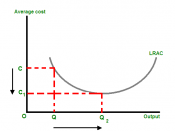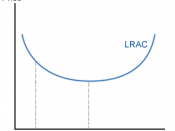Economies of Scale.
Economies of scale are traditionally defined as "a fall in the long run average cots of production as output rises" (Anderton). Figure 1 shows how economies of scale and diseconomies of scale occur in a graphical form.
Figure 1
The long run average cost curve is U-shaped because long run average costs:
1.at first fall over the output up until output O, showing economies of scale
2.then rise again when output exceeds the point O showing diseconomies of scale.
At the output level O a firm would experience the most efficient scale of production (MES) and thus would produce at the minimum cost level of production. In defining economies of scale we have to assume "ceteris paribus", also that technology remains constant, as do factor costs and that there is maximum efficiency at every level of output. If we assume that firms will want to maximise profits then it initially becomes clear why they will try to reach their MES.
The LRAC is derived form the SRAC. However in the long run all factors are variable, but in the short run at least one factor is fixed. This essay will look at the sources of economies of scale and show how they can be used in understanding industrial structure.
There are several reasons why economies of scale exist. They can exist due to increasing or decreasing (for diseconomies of scale) returns to scale. These are known as technical economies. These occur from what happens in the production process. Taking an example of a machine that produces fabric, which a small firm may use on average 5 times a week. However a larger firm may use the machine 10 times a week. The total price of the machine will be the same independent of whether it...


